

Implicit Learning: Researchers Uncover How to Learn Without Trying. It’s rare that a computer science lab brings us a scenario worthy of a spy novel, but that’s what happened earlier this month when Hristo Bojinov, a researcher at Stanford University, divulged his latest project.
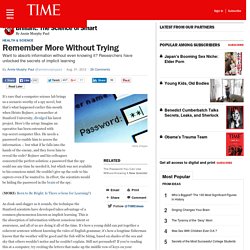
Here’s the setup: Imagine an operative has been entrusted with top-secret computer files. 12 Dozen Places To Educate Yourself Online For Free. All education is self-education.
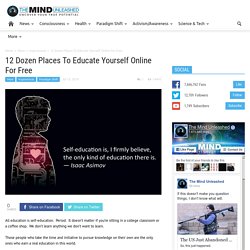
Period. It doesn’t matter if you’re sitting in a college classroom or a coffee shop. We don’t learn anything we don’t want to learn. Those people who take the time and initiative to pursue knowledge on their own are the only ones who earn a real education in this world. Making the Impossible–Possible — Love. Learn. Live. Do Students Really Need Practice Homework?
From Chapter 6 of The Homework Myth (Da Capo Press, 2006) Copyright © 2006 by Alfie Kohn Do Students Really Need Practice Homework?
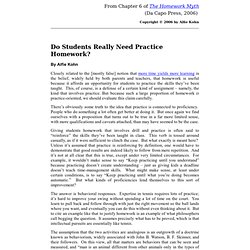
By Alfie Kohn Closely related to the [mostly false] notion that more time yields more learning is the belief, widely held by both parents and teachers, that homework is useful because it affords an opportunity for students to practice the skills they’ve been taught. From The Schools Our Children Deserve. From Chapter 9: "Getting the 3 R's Right" in The Schools Our Children Deserve (Boston: Houghton Mifflin, 1999) What Works Better than Traditional Math Instruction.
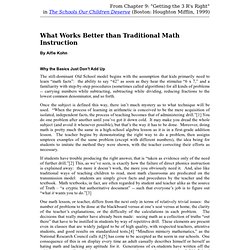
Web Seminars. Science and literacy instruction in the elementary grades was the focus of a series of web seminars conducted during the 2010-2011 school year.
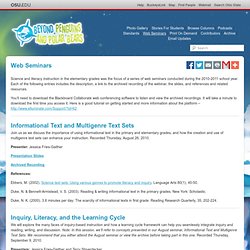
Each of the following entries includes the description, a link to the archived recording of the webinar, the slides, and references and related resources. You’ll need to download the Blackboard Collaborate web conferencing software to listen and view the archived recordings. It will take a minute to download the first time you access it. Here is a good tutorial on getting started and more information about the platform – Informational Text and Multigenre Text Sets Join us as we discuss the importance of using informational text in the primary and elementary grades, and how the creation and use of multigenre text sets can enhance your instruction.
Say the change you want to see. For schools embarking on a change process, one key success factor is envisioning what that change looks like and sharing the vision widely. In many of the schools we work with, the change involves a vision of students and teachers working together to use technology tools in new ways. They envision empowered students stepping up and taking part in the effort to improve education.
They see teachers who feel more comfortable about technology. They see students and teachers as co-creators of the learning environment. Www.sovela.net/blogs/mestrado/wp-content/uploads/2011/06/doc6.pdf. The Laboratory School at the Dr. Eric Jackman Institute of Child Study. Carly's Café - Experience Autism Through Carly's Eyes Back to school – games for collaboration and teamwork. Of course we want to encourage students to collaborate and work in teams – but how does this actually happen? Here’s one idea to kickstart that idea and keep it going all year long – games.
But not just any game! Games specifically designed to encourage teamwork and collaboration. Replace simple “icebreakers” with games that set the standard for positive interaction. As time goes on, introduce other games that pave the way for even deeper group work. Check out this article - “Why Play Games When There’s Work to Do? Games can be a catalyst for deeper goals. Two categories of games are especially helpful in setting a tone of collaboration and teamwork for students.
Cooperative games emphasize participation, challenge, and fun, rather than sorting out winners and losers. Initiative games have players attack a problem and solve it. Turning A Library Into A Maker Space. The next time someone tells you that libraries have no function because of the growing popularity of e-readers, direct them towards the Westport Library--a Connecticut library that just opened a MakerSpace--a place where people can tinker and create projects--for the local community.

Because in case you haven’t taken a trip to your local library recently, libraries are no longer just for books. How to Help Students Develop Passion for Writing. In an earlier post, I included a video that can be used to introduce students to a Writer’s Notebook.

After two weeks of working with a new group of students, students have written more than ten entries and have reflected on their writer’s journals. Here are some student reflections: Individual Lessons Each writing lesson provided students with a different writing idea to try, but no lesson required students to write in a certain way. My “ideas to try” came from a few sources: The Overarching Goal. Their First 15 Minutes; Identity Day. As June goes in schools, it is an extremely busy month. I have been in schools where we are just trying to make it to the end, but 5 school days from being over, I was lucky enough to be a part of one of the most memorable days in my teaching career. Forest Green hosted it’s first “Identity Day” and it was a tremendous success .
This was from the hard work and culminating effort from the ENTIRE school community but was led by my fabulous Assistant Principal, Cheryl Johnson. The institute @ CESA #1 Home - CESA 1. Stages of Personalized Learning Environments. The Stages of Personalized Learning Environments (PLE) needed to be updated again. Why? Because of the considerable feedback we received from participants in our 5 W's of Personalized Learning eCourse about our first and second versions of the chart. Some of the feedback was about consistency and flow across the stages.
Connected Learning Infographic. Toolkit. Our Personalize Learning Toolkit includes resources that can help your school or organization personalize learning for all learners.
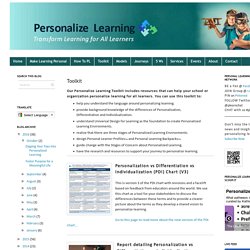
Forum: It’s Personal – Personalized Learning for Students and Educators. Key Questions.
